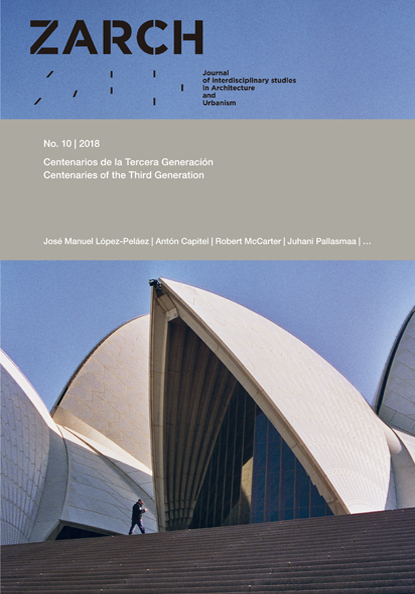The circle without center. Modern, classical and vernacular tradition in the Visser House by Aldo van Eyck
DOI:
https://doi.org/10.26754/ojs_zarch/zarch.2018102932Keywords:
van Eyck, Visser House, Otterlo circles, vernacular, in-between, kivaAbstract
An extraordinary interest in the vernacular, the primitive and the popular went through post-war Europe in the 1950s. It is a period of great industrial development that will also show, probably by contrast, a revived interest in tradition. How to approach the dichotomy between industrial society and tradition is a central issue of the architectural debate of that time, carried out by architects born between wars, the Third Generation of the Modern Movement, and is the context of this text: an exploration on how tradition, and especially "the vernacular", influenced the proposals made by Aldo van Eyck (1918-1999), in his work of transferring to architecture what had already happened in the art of the avant-garde at the early twentieth century, and in science with the Theory of Relativity. Van Eyck presented at the last CIAM held at the Kröller Müller Museum, the Otterlo circles, a diagram formed by two circles that represent the interrelation, “the in-between”, between the three great traditions: classical, modern and vernacular. This paper delves deeper into the work carried out by Van Eyck, in the Visser House extension (1967-1969), developed as an interpretation in Holland of a "kiva" -the Pueblo Indians sacred place-, and a paradigmatic example of the interrelation mentionated.
Downloads
References
Drew, Philip. 1973. Tercera generación. La significación cambiante de la arquitectura. Barcelona: Gustavo Gili.
Giedion, Sigfried. 2009. Espacio, tiempo y arquitectura: origen y desarrollo de una nueva tradición. Ed. definitiva. Barcelona: Reverté.
Guidoni, Enrico. 1977. Arquitectura primitiva. Madrid: Aguilar.
Hertzberger, Herman; Van Roijen-Wortmann, Addie; Strauven, Francis. 1982. Aldo van Eyck, Amsterdam: Stichting Wonen.
Hertzberger, Herman. 1991. Lessons for students in Architecture. Rotterdam: 010 Publishers.
_____. 2000. Space and the Architect. Lessons in architecture 2. Rotterdam: 010 Publishers.
Jaschke, Karin. 2011. Aldo van Eyck and the Dogon Image=Aldo van Eyck y la imagen Dogon. En Architects´journeys: bulidings, travelling, thinking=Los viajes de los arquitectos: construir, viajar, pensar, eds. Craig Buckley y Pollyana Rhee, 72-103. New York: GSAPP Books-Pamplona: T6 Ediciones.
Kuper, Marijke. 2006. Las casas de Rietveld. Rietvled’s houses. En Gerrit Th. Rietveld. Casas. Houses. 2G : revista internacional de arquitectura 39-40: 34-261.
Labadie, Marc y Bert Tjhie, eds. 1988. Indesem 87: International Design Seminar; April 6-10 University of Technology Delft. Delft: Delft University Press.
Ligtelijn, Vincent. 1999. Aldo van Eyck: Works. Basel-Boston-Berlin: Birkhäuser.
Ligtelijn, Vincent y Francis Strauven, eds. 2008. Aldo van Eyck. Writings. Collected articles and other writtings 1947-1998. Amsterdam: Sun Publishers.
Risselada, Max y Dirk van den Heuvel. 2005. Team 10, 1953-81: in search of a utopia of the present. Rotterdam: NAI Publishers.
Rodríguez García, Ana. 2015. Nagele. Identidad, modernidad y tradición. En Comunidad, Común, Comuna, ed. Fernando Quesada, 119-47. Madrid: Ediciones Asimétricas.
_____. 2016. Huellas de lo vernáculo en Team 10. Alison y Peter Smithson, Aldo van Eyck, José Antonio Coderch. Tesis Doctoral. Departamento de Proyectos Arquitectónicos, Escuela Técnica Superior de Arquitectura de Madrid.
Smithson, Peter. 1975. Church at The Hague by Aldo van Eyck. Architectural Design 6: 345-50.
Strauven, Francis. 1998. Aldo van Eyck: the shape of relativity. Amsterdam: Architectura & Natura
_____. 2007. Aldo van Eyck - Shaping the New Reality. From the In-between to the Aesthetics of Number. CCA Mellon Lectures 12 (mayo): 1-20.
Van Doesburg, Theo. 1927. Actividad de la arquitectura moderna holandesa II. Arquitectura 98, (junio): 213-20.
Van Eyck, Aldo. 1959a. Talk at the Otterlo Congress. En Vincent Ligtelijn y Francis Strauven eds. Aldo van Eyck. Writings, 199-201.
_____. 1959b. Is architecture going to reconcile basic values?. En Vincent Ligtelijn y Francis Strauven eds. Aldo van Eyck. Writings, 202-5.
_____. 1962. The Child, the City, and the Artist. Amsterdam: Sun Publishers. Editado y publicado por primera vez por Francis Strauven y Vincent Ligtelijn, 2006.
_____. 1970. Dall´Olanda: una casa per una collezione. Intervento di Aldo van Eyck in un edificio di Rietveld. Domus 491, (ottobre): 16-20.
_____. 1981a. Ex Turico aliquid novum. En Vincent Ligtelijn y Francis Strauven eds. Aldo van Eyck. Writings, 14-25.
_____. 1981b. Aldo van Eyck, Projekten 1948-1961. Groningen: Akademie van Boukunst.
_____. 1982. Transparency. En Vincent Ligtelijn y Francis Strauven eds. Aldo van Eyck. Writings, 494-7.
_____. 1983. Aldo van Eyck, Projekten 1962-1976. Groningen: Akademie van Boukunst
_____. 1986. Niet om het even… wel evenwaardig, van en over Aldo van Eyck. Rotterdam: Stichting Rotterdam Maaskant – Amsterdam: Van Gennep.
_____. 1987. The circle and the centre. En Marc Labadie y Bert Tjhie eds. Indesem 87, 184-5.
VV.AA. 1983. AX BAX. Aldo van Eyck. AOHNA 1983. Athens: The National Gallery and Alexander Soutzos Museum - Amsterdam: Visual Arts Offcie for Abroad of the Ministry of Welfare, Health and Culture Affairs of the Netherlands.
ZIJL, Ida van. 2010. Gerrit Rietveld. London: Phaidon.


